28 de December de 2022
Boxer Velocity, Strength and Explosiveness Training
Why is velocity training important for the boxer?
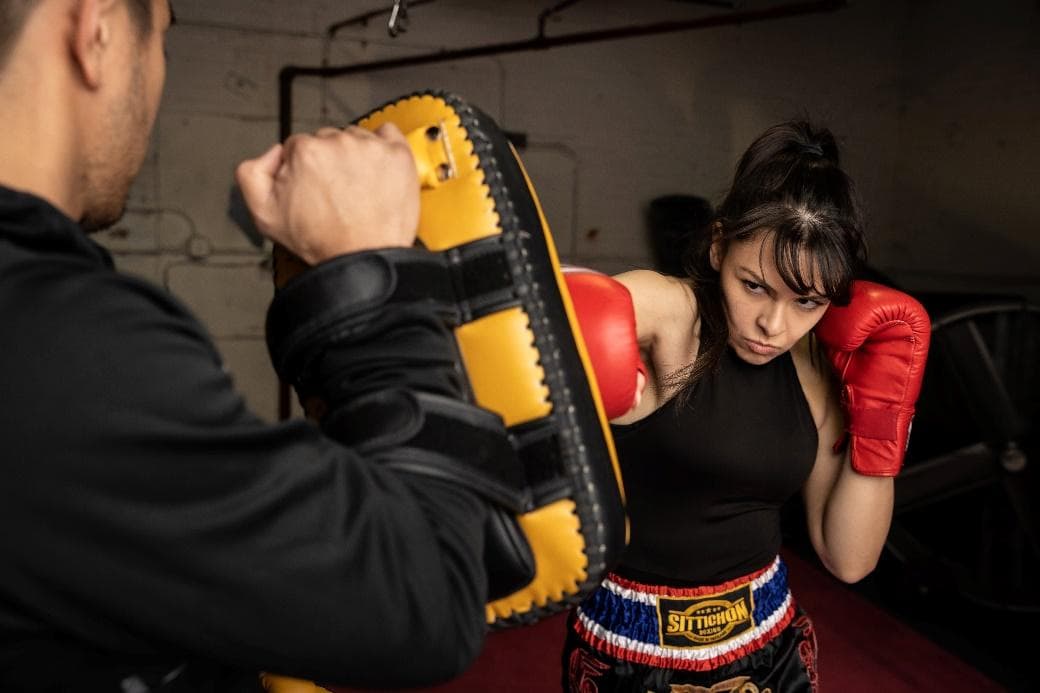
The main objective of boxing is to land a clean blow to the opponent without receiving any in return. The greater the impact against the opponent’s head or torso, the greater the likelihood of success in achieving a knockdown or knockout, as well as to get a better score from the judges (Dunn, Humberstone, Iredale, & Blazevich, 2019). Punches start from a quick muscular movement of the whole body that ends with impact on the opponent. To be successful and deliver accurate and forceful punches during the course of a bout, boxers require a well-developed cardiovascular and neuromuscular system.
In this article, we will not delve into cardiovascular development, although the scientific literature clearly states that it is vital in boxing (Smith, 2006). Nor will we go into the technical part, which also plays an important role in the boxer’s speed training. We will focus on the role and training of the neuromuscular system, i.e., muscular strength, as a differentiating element of elite boxers (Beattie & Ruddock, 2022). Punch impact force differentiates novice, intermediate and advanced boxers (Dinu, Millot, Slawinski, & Louis, 2020).
Maximal strength and high rate of force development, accompanied by refined technique and cardiovascular support to last the whole fight, is the perfect mix to consider when addressing how to train velocity in boxing (Loturco et al., 2016; Ruddock, Wilson, Thompson, Hembrough, & Winter, 2016). Therefore, boxer’s velocity training is fundamental when it comes to increase our level in boxing, as well as to have higher chances of success in combat.
How to train the velocity in boxing?
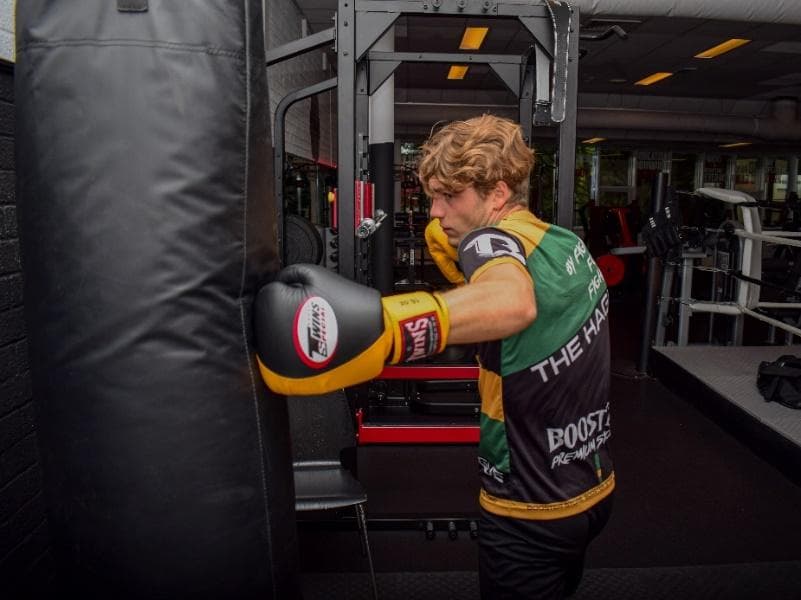
Boxing movements involve rapid skeletal muscle actions, which highlights the importance of developing large magnitudes of force in short periods of time. Second, the momentum of the striking arm is important and has been shown to be a key variable contributing to the impact of a punch (Nakano, Iino, Imura, & Kojima, 2014). Finally, a second pulse in muscle activation is required at the moment of impact and has been defined as “stiffening” to create “effective mass” (McGill, Chaimberg, Frost, & Fenwick, 2010).
Basic boxing biomechanics
The three factors in the previous paragraph (rate of force development [RFD], momentum, and second pulse) are determined by the effectiveness of the boxer’s ability to generate force through hip, knee, and ankle extension, trunk rotation, and arm extension (Lenetsky, Harris, & Brughelli, 2013). However, boxing does not have a unique punch, far from it. That makes boxer velocity training require a large number of specific movements.
In boxing there are three main punches: straight punches, hooks and chin hooks. Each has different biomechanics that may involve a greater or lesser number of muscle groups. The jab is a direct punch and is one of the most important punches in boxing. A straight with the back hand, known as a “cross” is more damaging than the “jab” because it involves a greater impulse from the back leg that is aided by hip rotation (Lenetsky et al., 2020).
The hook is performed with another rotational motion and from the bottom up, producing the highest impact forces, making it the most damaging of all punches (Walilko, Viano, & Bir, 2005). So, we could continue with other blows such as the hook to the chin and derivatives, but the purpose of this information is to visualize that the velocity training of the boxer’s punch involves strength from the feet to the hand in all planes, and this should be how we should train velocity in boxing.
When it comes to how to train velocity in boxing, we must select base strength exercises with high loads and low velocities, as well as low loads with higher velocities. We have seen in previous paragraphs that we should not only focus on the arms when training the boxer’s velocity, but the legs and trunk also have a key role, even more important than the upper body.
Boxer’s velocity training: the base of the pyramid
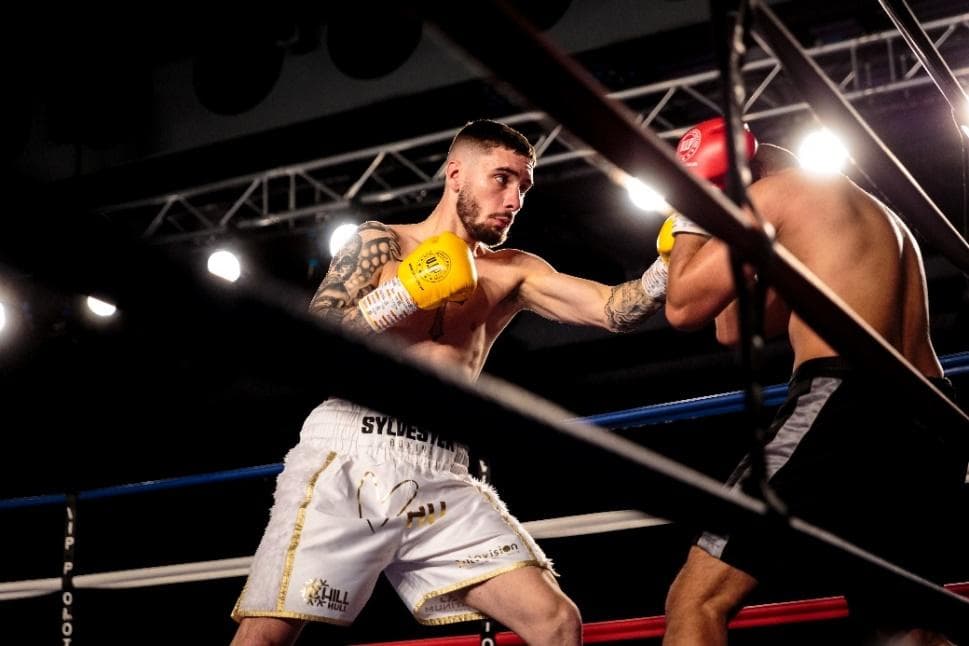
Gaining muscle mass in the arms
Newton said it clearly a long time ago: force = mass x acceleration. To increase force, we can increase mass, acceleration or both. This law that has been in force for centuries invites us to increase the muscle mass of our arms so that the impact is greater (Ruddock et al., 2016). Furthermore, increasing muscle cross-sectional area (CSA) is related to the potential to imprint more maximal and explosive force (Suchomel, Nimphius, Bellon, & Stone, 2018). We find here a full-fledged two-for-one: by gaining arm mass we will have more strength because of Newton’s Law; and muscle hypertrophy also helps to produce more force.
The first preparatory phases when we are far from competition should be dedicated to this objective of increasing muscle mass in the arms. It will also serve as an anatomical adaptation to prepare the body for the higher loads that we will use in the next phase. The only “but” that the increase of arm weight has in the boxer’s velocity training is that we cannot forget the weight limits. Each category establishes limits that we must not exceed, so it will not always be an option to add muscle mass to the boxer’s arms.
Lower and upper body maximal strength
Elite boxers who punch with higher impact forces have significantly higher levels of lower body maximal strength compared to boxers who punch with less impact (Dunn, Humberstone, Franchini, Iredale, & Blazevich, 2022). Therefore, and although it is often thought otherwise, lower body strength is equally or more important than upper body strength in hitting faster and more explosively (Beattie & Ruddock, 2022).
In a training seminar, I heard that “in a bigger glass you can fit more things”. The glass is maximal strength and the other things are the different manifestations of sport specific strength. On many occasions we focus on those other things with specific work, but forget to make the glass bigger. Maximal strength is a critical component of explosive strength capacity (Cormie, McGuigan, & Newton, 2011). If we are looking at how to train velocity in boxing, the foundation starts with improving maximal strength.
For this goal we will use basic lower body and upper body exercises that have a transfer to boxing punches. Squats, deadlifts and hip thrusts are the three great lower body classics to improve maximal strength, while bench press and military press are the two upper body basics. The recommended boxer velocity training in this case is to use high loads (80% of 1RM or more) with low reps.
A very important, and often overlooked nuance is that the loads must be moved at the maximum intentional velocity. From the outside, the movement with high loads will look slow, but the boxer has to be pushing the load with the maximum possible velocity, whatever the actual velocity is. A velocity measuring device like Vitruve’s is very interesting in this aspect because it gives us immediate feedback on the velocity of each repetition. That serves us on the one hand to prescribe training, and on the other hand to motivate the athlete to lift as fast as possible (Weakley et al., 2020; Włodarczyk, Adamus, Zieliński, & Kantanista, 2021).
Boxer’s velocity training: the more specific part

Adapted Olympic movements: medium loads and medium velocities
Once we have enlarged the vessel with high loads and slow, yet intentionally maximum velocity, we will continue to ride the strength-velocity curve. Olympic movements are basic to improve lower body momentum, as well as coordinated core and arm movement. Performing a pure pull-up or snatch is not within everyone’s reach, because they are very technical.
However, we can use variations of these, such as one-handed dumbbell work, or shortening the entire movement by doing hanging carries and snatches. Importantly, this explosive work needs to be present in the boxer’s velocity training because current literature suggests that explosive strength, both lower and upper body, is largely associated with punch impact strength in elite boxers (Lopez-Laval, Sitko, Muniz-Pardos, Cirer-Sastre, & Calleja-Gonzalez, 2020; Loturco et al., 2016).
Transfer to boxing: low loads and high velocities
Following the strength-velocity curve, we are approaching the specificity of the boxing punch, which requires maximum velocity with no load beyond the weight of the arm. The strength base we have developed with maximum strength training must be transferred to the impact of the punch, which is achieved with explosive strength training and boxer-specific s velocity training.
The momentum of the lower body, vital for the velocity of the punch, will benefit from explosive exercises such as squats or deadlifts at the maximum possible velocity with medium and low loads, as well as all kinds of jumps and plyometrics. The goal is that the start of the punch comes out with as much momentum as possible from our legs. Bench press barbell throwing, seated medicine ball throwing, plyometric push-ups, etc. can be used to control the boxer’s upper body explosive strength adaptations (Loturco et al., 2021).
The speed of the arm is important, but “making it strong” at the moment of impact is also important.
The velocity of the blow is important, but so is the peak force that occurs right at the moment of impact with the opponent. An accurate hit will be the one with the minimum loss of energy at impact (Ruddock et al., 2016). To train this section we will work with hits to pads and heavy sacks, while the trainer will give feedback to harden in that right part when the arm impacts.
Another way to train is by isometric contractions combined with rapid relaxation. This work can be done with those pads or heavy sack, or also by adopting the final punching position with an elastic band or cable on a pulley. Trunk training can also be used as a means to facilitate improvements in “effective mass” generation by increasing isometric force production at impact. Trunk training is discussed in the next section.
The core as a driver of the lower body momentum
Pelvic and trunk velocity and stability are likely to contribute to increased hand velocity during a punch (Ruddock et al., 2016). To cover the boxer’s velocity training in all punches, we must train our mid-zone in all planes: frontal, lateral and rotational. Ideally, it should be accompanied by the punching gesture itself to make it as specific as possible. Here are some examples of exercises to improve the boxer’s punching velocity.
Lunge woodchop https://www.youtube.com/watch?v=SlI6xLUmX5s
Medicine Ball Rotational Punch Slam https://www.youtube.com/watch?v=9dWwmyZ1Wng
Landmine punch https://www.youtube.com/watch?v=NGOeukXF4yE
Some extra considerations on how to train velocity in boxing
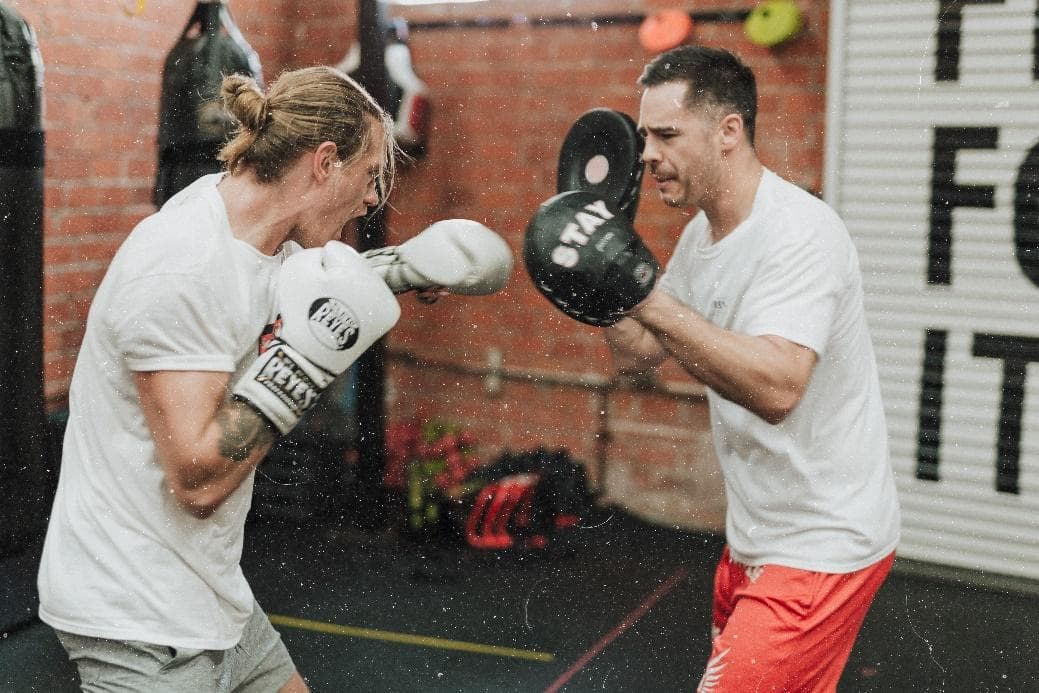
We have to make weight before the competition
One factor that comes into play in boxing, and other sports that establish weight categories, is the compromise of strength when it comes to dropping weight in order to compete in a given category. When there is a calorie deficit, our strength and velocity can be compromised (Halperin, Hughes, & Chapman, 2016). To avoid this, it is advisable to follow dietary guidelines that make us lose weight slowly, thus avoiding the loss of performance in training, and the possible loss of muscle mass, also important when the impact of the punch is greater.
During the last weeks of the preparation, when sparring, it is a priority and that the boxer is exposed to an energy deficit for the weigh-in, strength training will be done with very little volume, but respecting a high intensity in order not to lose punching velocity.
Evaluation of the boxer’s velocity training
The height of the jump depends on the momentum of the lower body, and the impact force depends on the momentum. Therefore, measuring jump height with velocity measuring devices such as Vitruve’s can show very simply and quickly if you are improving this quality, and with-it punching velocity. Other ways to measure whether the boxer’s training is being fruitful is by checking the velocity at which we move the bar or the distance at which we throw a medicine ball (Ruddock et al., 2016).
Practical example of 12 weeks training until the fight to gain boxer’s impact velocity.
The time has come to present in a practical way all that has been discussed so far. The authors of a very complete research on the recommendations of physical preparation in boxing, propose a practical example of the 12 weeks prior to the fight (Ruddock et al., 2016). The left column of the following table shows the skills to focus on, as well as the variables to consider.
In the other three columns, we can visualize the difference between the 8-12 weeks prior, 4-8 weeks prior and the last three weeks until the fight. As we have described in this article, we will start with general strength training to finish with more specific exercises and loads. It is a very complete table that is worth looking at carefully and having saved as a boxer’s velocity training to go to when we want to know how to train velocity in boxing.
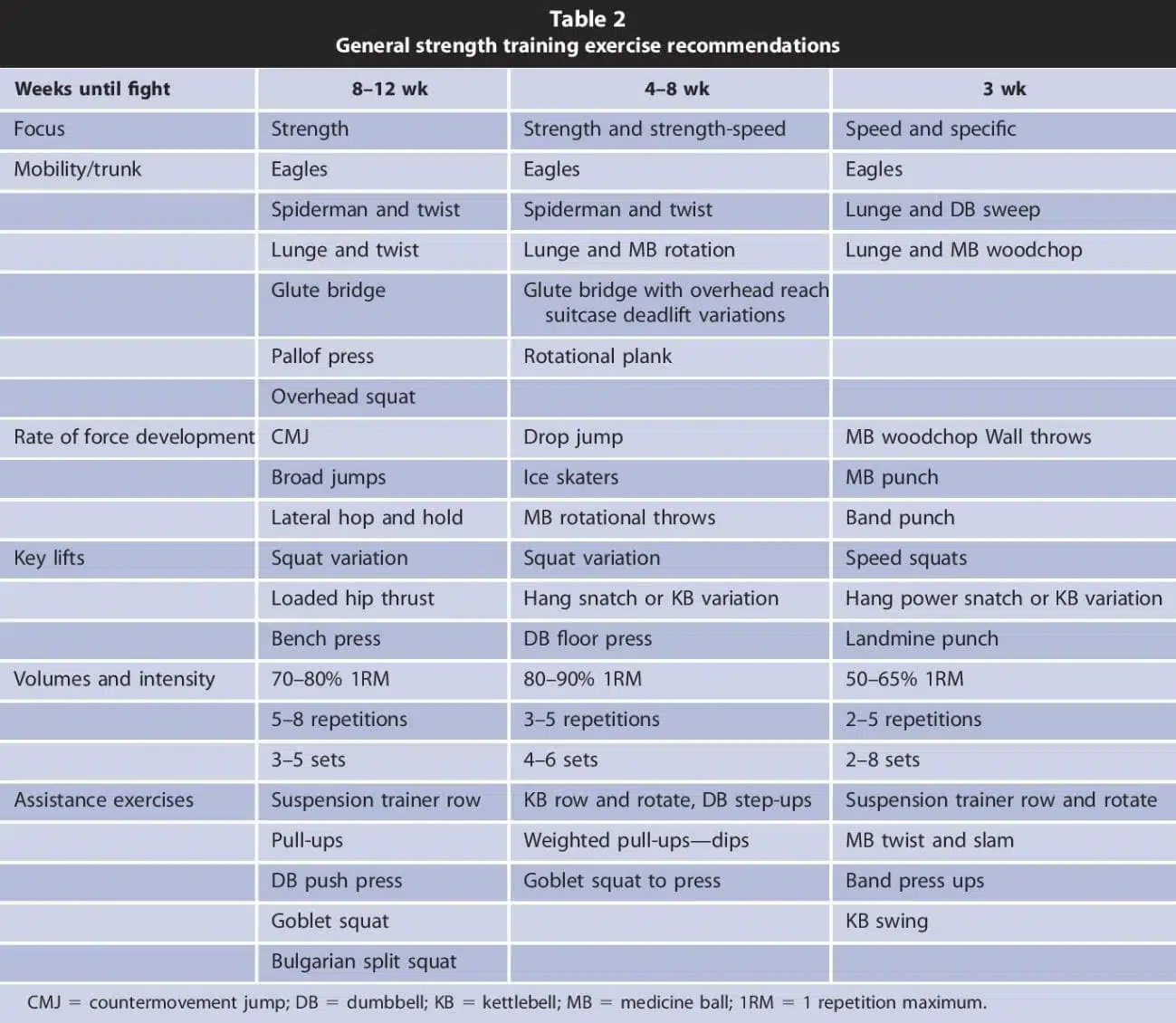
Table extracted from (Ruddock et al., 2016)
Joaquin Vico Plaza
References
Beattie, K., & Ruddock, A. D. (2022). The Role of Strength on Punch Impact Force in Boxing. Journal of Strength and Conditioning Research, 36(10), 2957–2969. https://doi.org/10.1519/JSC.0000000000004252
Cormie, P., McGuigan, M. R., & Newton, R. U. (2011). Developing maximal neuromuscular power: Part 1–biological basis of maximal power production. Sports Medicine (Auckland, N.Z.) , 41(1), 17–38. https://doi.org/10.2165/11537690-000000000-00000
Dinu, D., Millot, B., Slawinski, J., & Louis, J. (2020). An Examination of the Biomechanics of the Cross, Hook and Uppercut between Two Elite Boxing Groups. Proceedings 2020, Vol. 49, Page 61, 49(1), 61. https://doi.org/10.3390/PROCEEDINGS2020049061
Dunn, E. C., Humberstone, C. E., Franchini, E., Iredale, K. F., & Blazevich, A. J. (2022). Relationships Between Punch Impact Force and Upper- and Lower-Body Muscular Strength and Power in Highly Trained Amateur Boxers. Journal of Strength and Conditioning Research, 36(4), 1019–1025. https://doi.org/10.1519/JSC.0000000000003585
Dunn, E. C., Humberstone, C. E., Iredale, K. F., & Blazevich, A. J. (2019). A damaging punch: Assessment and application of a method to quantify punch performance. Translational Sports Medicine, 2(3), 146–152. https://doi.org/10.1002/TSM2.71
Halperin, I., Hughes, S., & Chapman, D. W. (2016). Physiological profile of a professional boxer preparing for Title Bout: A case study. Journal of Sports Sciences, 34(20), 1949–1956. https://doi.org/10.1080/02640414.2016.1143110
Lenetsky, S., Brughelli, M., Nates, R. J., Neville, J. G., Cross, M. R., & Lormier, A. V. (2020). Defining the Phases of Boxing Punches: A Mixed-Method Approach. Journal of Strength and Conditioning Research, 34(4), 1040–1051. https://doi.org/10.1519/JSC.0000000000002895
Lenetsky, S., Harris, N., & Brughelli, M. (2013). Assessment and contributors of punching forces in combat sports athletes: Implications for strength and conditioning. Strength and Conditioning Journal, 35(2), 1–7. https://doi.org/10.1519/SSC.0B013E31828B6C12
Lopez-Laval, I., Sitko, S., Muniz-Pardos, B., Cirer-Sastre, R., & Calleja-Gonzalez, J. (2020). Relationship Between Bench Press Strength and Punch Performance in Male Professional Boxers. Journal of Strength and Conditioning Research, 34(2), 308–312. https://doi.org/10.1519/JSC.0000000000003362
Loturco, I., Nakamura, F. Y., Artioli, G. G., Kobal, R., Kitamura, K., Cal Abad, C. C., … Franchini, E. (2016). Strength and Power Qualities Are Highly Associated With Punching Impact in Elite Amateur Boxers. Journal of Strength and Conditioning Research, 30(1), 109–116. https://doi.org/10.1519/JSC.0000000000001075
Loturco, I., Pereira, L. A., Kobal, R., Fernandes, V., Reis, V. P., Romano, F., … McGuigan, M. (2021). Transference Effect of Short-Term Optimum Power Load Training on the Punching Impact of Elite Boxers. Journal of Strength and Conditioning Research, 35(9), 2373–2378. https://doi.org/10.1519/JSC.0000000000003165
McGill, S. M., Chaimberg, J. D., Frost, D. M., & Fenwick, C. M. J. (2010). Evidence of a double peak in muscle activation to enhance strike speed and force: an example with elite mixed martial arts fighters. Journal of Strength and Conditioning Research, 24(2), 348–357. https://doi.org/10.1519/JSC.0B013E3181CC23D5
Nakano, G., Iino, Y., Imura, A., & Kojima, T. (2014). Transfer of momentum from different arm segments to a light movable target during a straight punch thrown by expert boxers. Journal of Sports Sciences, 32(6), 517–523. https://doi.org/10.1080/02640414.2013.843014
Ruddock, A. D., Wilson, D. C., Thompson, S. W., Hembrough, D., & Winter, E. M. (2016). Strength and Conditioning for Professional Boxing: Recommendations for Physical Preparation. Strength and Conditioning Journal, 38(3), 81–90. https://doi.org/10.1519/SSC.0000000000000217
Smith, M. S. (2006). Physiological profile of senior and junior England international amateur boxers. Journal of Sports Science & Medicine.
Suchomel, T. J., Nimphius, S., Bellon, C. R., & Stone, M. H. (2018). The Importance of Muscular Strength: Training Considerations. Sports Medicine (Auckland, N.Z.) , 48(4), 765–785. https://doi.org/10.1007/S40279-018-0862-Z
Walilko, T. J., Viano, D. C., & Bir, C. A. (2005). Biomechanics of the head for Olympic boxer punches to the face. British Journal of Sports Medicine, 39(10), 710–719. https://doi.org/10.1136/BJSM.2004.014126
Weakley, J., Wilson, K., Till, K., Banyard, H., Dyson, J., Phibbs, P., … Jones, B. (2020). Show Me, Tell Me, Encourage Me: The Effect of Different Forms of Feedback on Resistance Training Performance. Journal of Strength and Conditioning Research, 34(11), 3157–3163. https://doi.org/10.1519/JSC.0000000000002887
Włodarczyk, M., Adamus, P., Zieliński, J., & Kantanista, A. (2021). Effects of Velocity-Based Training on Strength and Power in Elite Athletes—A Systematic Review. International Journal of Environmental Research and Public Health, 18(10). https://doi.org/10.3390/IJERPH18105257

